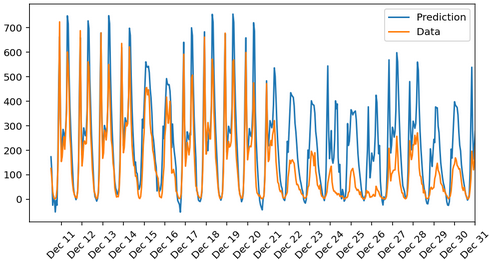This repository hosts all projects that I was working on during the Udacity Deep Learning program. Course highlights include the development of multi-layer neural networks, convolutional neural networks, recurrent neural networks and generative adversarial networks.
The task of this project was to build and train a neural network from scratch to predict the number of bikeshare users on a given day.
The dataset has the number of riders for each hour of each day from January 1 2011 to December 31 2012. The number of riders is split between casual and registered, summed up in the cnt column.
The network has two layers, a hidden layer and an output layer. The hidden layer will use the sigmoid function for activations. The output layer has only one node and is used for the regression.
I believe the prediction is quite good up to December 21. However, I notice that there is a general offset between prediction and test data. This means that training could still be improved, but I wanted to avoid overfitting. There is a negative prediction of bike users on December 16. This does not make sense. The output of the neural network must be limited to positive values only. Also, there is an obvious mismatch between prediction and test data starting from December 21 onwards. Although holidays are flagged in the dataset, I assume that the dataset is generally biased towards regular working days and not towards the holiday season. Concerning the general offset between prediction and test data, I believe it is a better idea to randomize weights each iteration instead just once in the class constructor.
The task of this project was to build a convolutional neural network for image classification. The code accepts any user-supplied image as input. If a dog is detected in the image, it will provide an estimate of the dog's breed. If a human is detected, it will provide an estimate of the dog breed that is most resembling.
I designed and trained my own convolutional neural network from scratch, and also applied transfer learning on a ResNet-101 model with a final accuracy of 85%.
The lower image confirms that neural networks are vulnerable towards adversarial attacks. The implemented CNN is not able to distinguish between a real face and a fake mask. Adversarial attacks are an important field of research for self-driving cars, since computer vision algorithms for traffic light and street sign detection could be fooled in similar ways.
The task of this project was to build a recurrent neural network for text generation. The model was trained with a dataset consisting of Seinfeld TV scripts. It produces some dialog based on the patterns it has learned in this training data.
Starting with the word jerry as the input seed, this recurrent neural network predicts a series of next words until it has reached a set length of 200 words. These types of models have a kind of built-in memory which are really useful in prediction tasks that are time or sequence dependent.
jerry: hey!
jerry: i can't believe this, i was in the hospital to be a little more tactful.
george: you know what? you know, i have a very bad idea.
george: what is it?!!
kramer: (to jerry) you got the job?
helen: i don't know why we had a little more time.
jerry: i think i can see the whole thing, and i was thinking of a little problem with you?
george: (looking at the tv)
jerry: i think you're going to go. (to george) hey, you gotta see the doctor?
elaine: no, no. no.
newman: (to jerry) you know i don't know what you think.
kramer: oh yeah, you know i was gonna get out
The model output does not make perfect sense. The data pre-processing step could be improved by removing frequent words such as "the", "to", "no", etc. This is only noise. Additional hidden layers could be introduced which would allow the model to learn more text features. Using a larger training dataset could help to improve semantic meaning.
The task of this project was to generate realistic images of human faces. I built a DCGAN which takes as input a latent vector based on a random uniform distribution, and outputs a color image. The model was trained on the CelebA dataset. The training images have been pre-processed into square images of somewhat-centered faces. This is how they look:
The model is comprised of two adversarial networks, the discriminator and generator. The discriminator network consists of three convolutional layers with batch normalization, and a final fully-connected layer for classification. The discriminator aims to classify its input images as either real data from the CelebA dataset or fake generated data. For this purpose, the generator tries to generate realistic-looking fake images that can fool the discriminator. The generator network consists of three transpose convolutional layers with batch normalization, and aims to upsample a latent input vector based on shape and color features that would fool the discriminator the best. In summary, both networks have opposing goals, and the target is to generate fake images that look very similar to the CelebA dataset. Here are some generated results:
I am quite surprised how well the DCGAN performed. The Generator definitely generated new images of faces that look realistic. You can even distinguish between men and women. I would not be able to tell that the two faces shown on the far bottom left corner were based from a random uniform distribution. But there are some obvious generation errors, such as weird color artifacts.
In terms of improvement, I would suggest to remove training images that show faces from the side. This is basically noise, because these images do not fall into the portrait category. Also, people with dark glasses might have negative influence on the training process. The black spot on the bottom right corner image may be related to this problem.
In the final project, I created a web app for binary sentiment classification of movie reviews. I trained a recurrent neural network with a LSTM layer on the IMDb dataset using SageMaker, and deployed it to production with a RESTful endpoint using Amazon's Lambda and API Gateway services. The end-to-end processing is depicted below:
Whenever a HTTP POST request from the web app is received by the API Gateway, the Lambda function is called and forwards the review content to the model's endpoint which is hosted on AWS. The model performs inference on this input data, and returns the classification result to the web app.
For testing I have selected a review based on the movie Jurassic Park, which has a 10-of-10 point score:
Closing remarks: I think it was a good decision to implement a RNN with LSTM cells for sentiment analysis. Models like this are sequence-dependent which enables them to store textual context in their cell state. Some movie reviews are ironic or sarcastic which may lead to false-positive classifications if a multi-layer perceptron would have been implemented instead.







